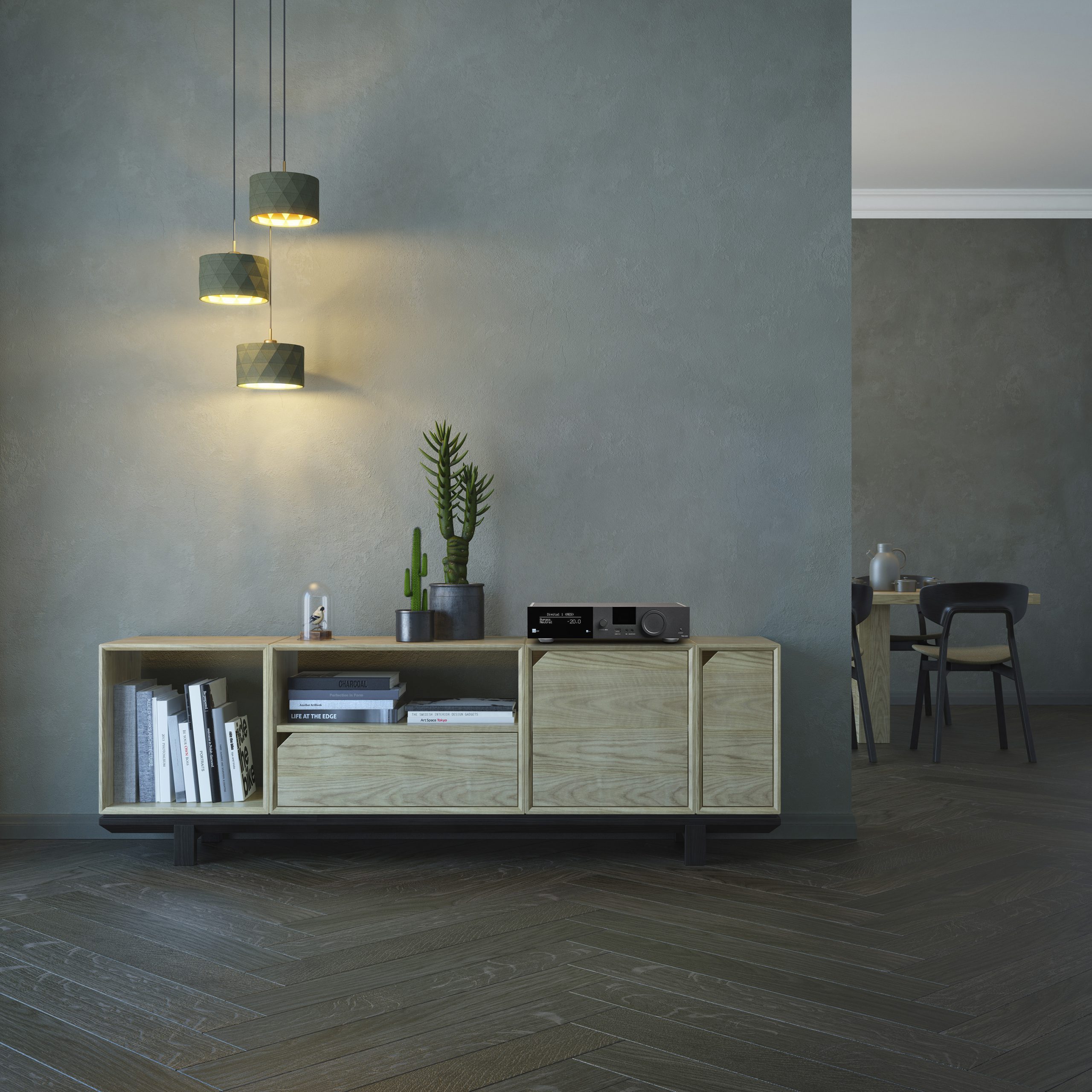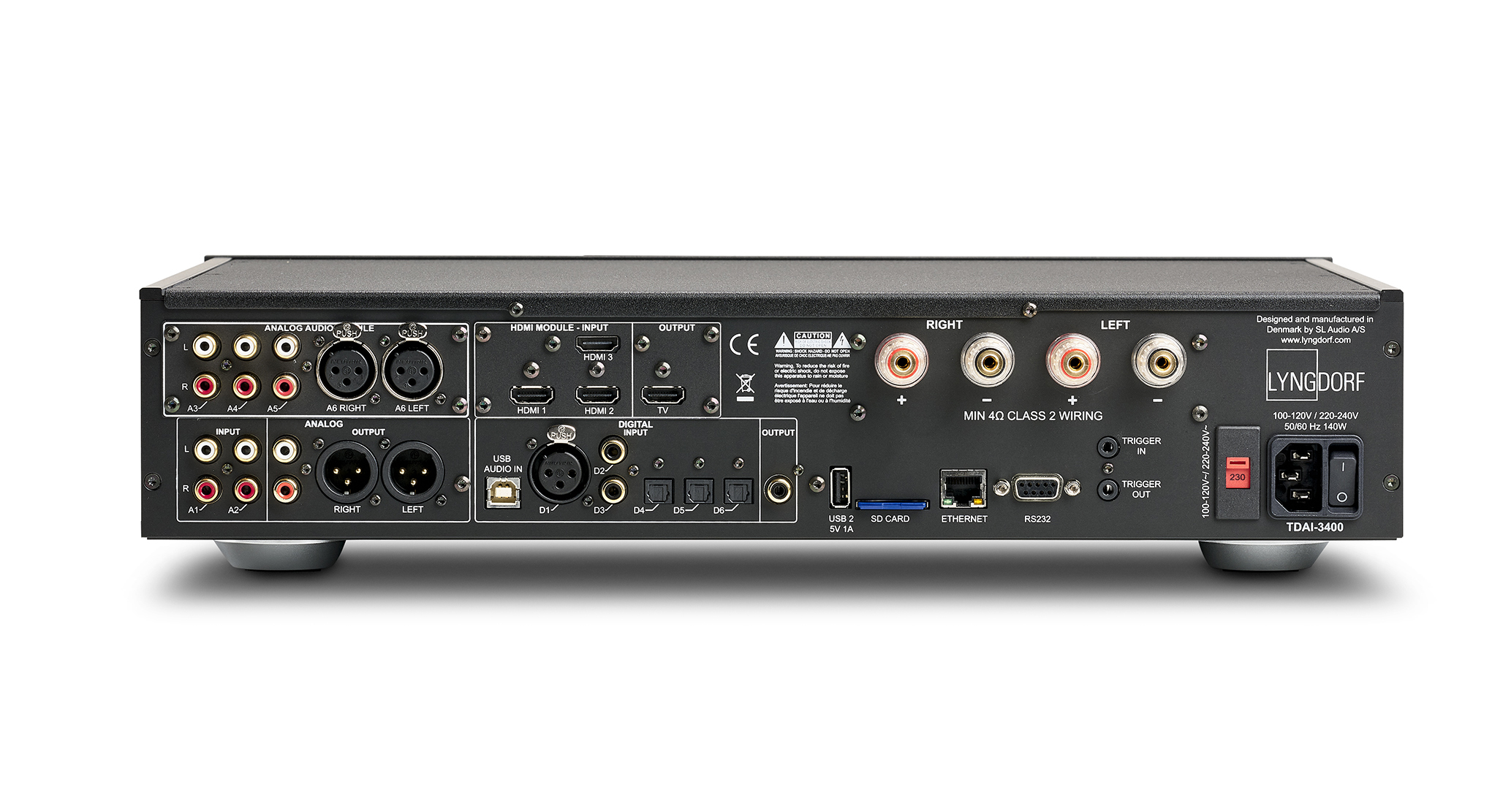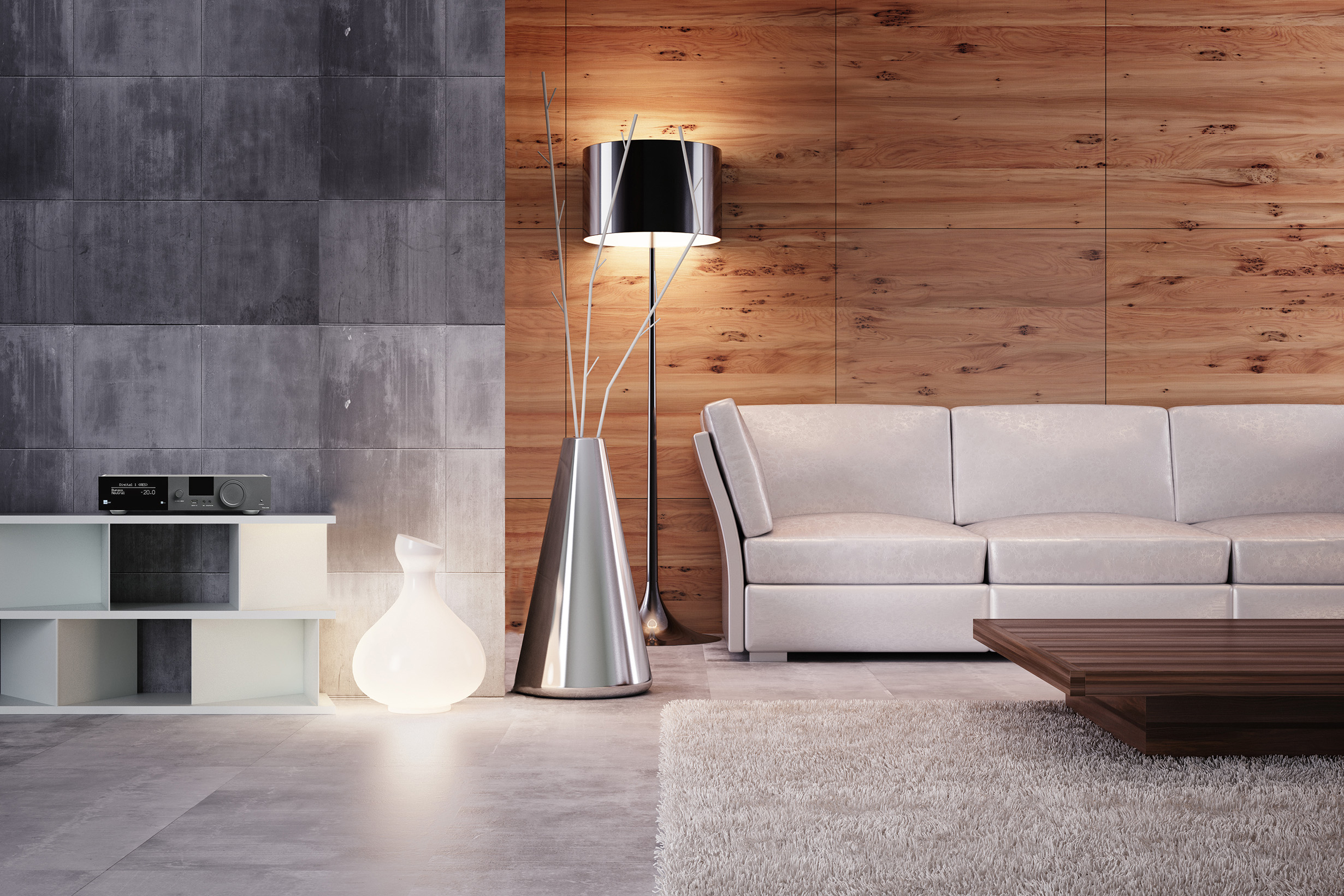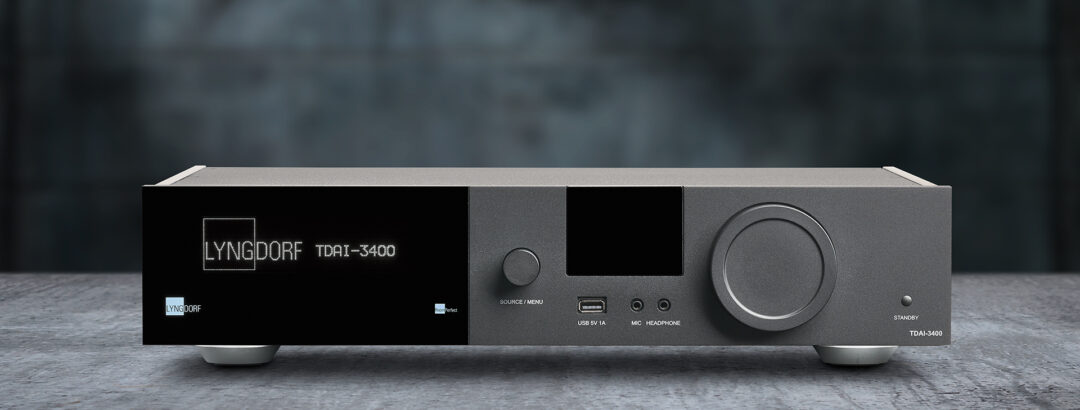What are the characteristics of the perfect hi-fi equipment? When we test products at the highest level of the scale, ostentatious design usually goes hand in hand with impressive sound. And usually also price. But not everyone is equally lavish.
The Lyngdorf TDAI 3400 almost looks like a piece of laboratory equipment designed by Philippe Starck: a carbon black box in strict, simple lines. The edges are razor sharp, and you can easily see how it is put together. No hocus pocus here. But solid and trustworthy. A large display covers the left side of the centimeter-thick front plate. Otherwise, the large volume knob is the element that steals the most attention. As on previous Lyngdorf products, the steering wheel is heavy, but it is easy to spin.
We have previously tested little brother TDAI 2170, which got a very good grade. The new model is more than twice as powerful, and also supports modern audio formats and network connection. Facts that are reflected in the price – which has also doubled.
With 2 x 200 W in 8 ohms, and twice as much in 4 ohms, the TDAI 3400 should be able to drive most of the speakers you can find to connect. The fully digital amplifier has digital inputs of all types – from Toslink to the professional balanced AES/ABU inputs. But there are also a couple of old-fashioned line inputs for unbalanced analog signals. And if that is not sufficient, the amplifier can be purchased in several different versions with additional inputs for special needs. There may be several analog inputs or a number of HDMI connections.
In addition to the regular inputs, there is of course a connection for wireless and wired networks as well as Bluetooth. There are no multi-room features, as with Gold Note, but it has Spotify Connect, internet radio via vTuner and media playback with Roon.
The sound quality
At Lyngdorf, they are not supporters of “sound” or “sound signature”. TDAI alone does not leave a noticeable fingerprint on the sound. With the built-in room correction, it removes aural color staining rather than the opposite. As a counterweight, it offers a number of settings, such as “Music”, “Relaxed” and “Action Movie”, so for example you can give the bass a little extra pressure when Avengers Endgame scrolls across the screen.

The battle between rooms and speakers
The room correction makes it possible – or even desirable – to place speakers in places that are contrary to the traditional acoustic teachings. To understand this we need to take a little tour of the world of acoustics:
When you place speakers on a stand, with a good distance from walls and corners, it is to avoid provoking room resonances. This gives a smoother (but still far from smooth!) frequency response in the bass area. You can not avoid room resonances, but the closer the speaker gets to delimiting surfaces, the more powerful they become.
On the other hand, longer distances to floors and walls mean that the reflections come with a greater delay. As a kind of echo. This echo has the ear hard to sort out. If you place the speakers right next to the wall, the reflection time becomes so short that the sound is perceived as if it comes from one source. An extreme example of that design perception is the late Stig Carlsson’s “orthoacoustic” principle, where the speakers are placed right next to the wall, which acoustically causes the wall to “disappear”.
In other words, the placement of a speaker is a choice between plague (in the form of uneven bass) and cholera (in the form of reflections). And with a little bad luck, one can actually be hit by both abominations at the same time. This is where the room correction comes into play.
The room correction can correct the irregularities in the frequency response. To some extent, mind you. Humps are easy to remove, while straightening a dip can require tremendous amounts of effect. And if the phasing out from standing waves is total in the listening position, there can still be many wasted watts.
I have recently tried three different room correction systems. All three improved the untreated sound, but Lyngdorf’s alternative gave the best results.
Isolates the speakers’ own sound
Room correction is not “just” a matter of measuring the frequency response with a microphone, and then adding enough digital equalizing to straighten the curve. An attempt to get a small bookshelf speaker to play deep bass will, firstly, force it beyond its limits. And secondly, it will change the sound of the speaker. The sound that may have been the reason why you chose that particular speaker. Last but not least, music is much more than pure sine tones. And a seemingly linear frequency response can hide a poor impulse response.
Lyngdorf explains in their material that they have chosen a different measurement method than most competitors. Instead of using short pulses of noise, it is measured with long sequences of sine tones. It is measured with 50 different tones in the range 20 to 350 Hz and 71 tones in the range from 350 Hz to 20 kHz. It comes with a microphone with a professional look and a microphone stand (!) bundled with the amplifier. In addition to a measurement in the “good chair”, a number of measurements are made at (at least four) random positions in the room. Based on this, the energy distribution in the room at all frequencies is calculated, in the same way as the speaker’s own frequency response is also calculated.
Quieter rendering
When the test started, a pair of Buchardt S400s were placed on a stand in the “correct” position. Here they got a lot of help from the RoomPerfect correction, which gave a subjectively calmer reproduction, where it was easier to hear the acoustics on the recording.
But Lyngdorf recommends – and uses itself – a wall placement of the speakers. The S400 speakers were therefore moved barely a meter backwards and up into the window frame, where they also came closer to the corners. Completely “wrong” in other words. And what an improvement! Without RoomPerfect, they actually sounded pretty good with their backs to the wall. And the bass was not as uneven as one might fear. But everything sounded a bit “hollow”.

Lifting the ceiling
With RoomPerfect turned on, the frequency response became calmer. But the biggest improvement was the rendering of perspective and space! The (acoustic) ceiling was simply lifted! From the feeling of listening through a window into the concert hall, it was now more like being in the room. At Fishing Junks at Sunset from Concerts in China, you could feel the huge hall from wall to wall and from floor to ceiling. The same impressive space rendering was experienced at “Banditen Galopp” (“Ein Straussfest” from Telarc).
On the opposite side of the acoustic scale, we get really close with Dark Ballet from Madonna’s Madame X. Here, the song is right in front of the speakers and the stage is small, while everything becomes increasingly dizzying and electronic.
An impossible task
To really put the room correction to the test, I found some gems in the form of a pair of Sonab OA5-II speakers, designed by the aforementioned Stig Carlsson. The fun thing about the exercise is that the old speakers are omnipolar, and that they use the walls of the room to create the big and beautiful soundscape.
Removing the room’s impact on a pair of speakers of that character is impossible, but the TDAI 3400 makes a persistent attempt. The result did not really sound bad – but very strange. With my head in just the right position, they sounded almost like a pair of normal speakers. But the slightest movement of the head made the soundscape incoherent.
Alternatives
There are many alternative amplifiers in the same price range as the TDAI 3400, but none that are quite similar. An alternative is the equally excellent Devialet Expert 140 Pro. In its digital interior, too, it has more in common with a computer than a classic amplifier, but lacks room correction. Devialet instead has its SAM (Speaker Active Matching), which corrects for deficiencies in a large database of passive speakers.
Free amplifier
The Lyngdorf TDAI 3400 is really expensive, and it can be difficult to convince external taste judges (such as spouses and bank advisers) of the necessity of such an investment. But one could argue that it is worth its price in real estate:
If you have a pair of standmount speakers placed at a proper distance from the walls, they easily occupy a few square meters of the living room floor. And if you own a home in a larger city, the price per square meter of space you will be able to take advantage of by hanging the speakers on the wall will easily exceed the price of the TDAI 3400.

Conclusion
Lyngdorf TDAI 3400 is a very unusual product. It’s not just a superbly executed amplifier in high-end quality, although the sound and the consistent construction – which is digital from input to output – could justify the price. What sets it apart from everything else in the class is the RoomPerfect system, which pushes the boundaries of what you can get out of both the speakers and your living room! There are super amplifiers with good sound that delight the soul more. But what good is a web site if it simply “blends in” with everything else out there?

We think
Lots of power, neutral sound - and a room correction that literally moves walls. And it makes the decor easier. Although it is affordable in terms of performance, it still costs so much that it is only for the few. The sound is good but not fat.
4795 €
Specifications
- Output power: 2 x 200 W in 8 ohms / 2 x 400 W in 4 ohms, digital
- Digital inputs: AES / EBU, 2 x coaxial (RCA), 3 optical (Toslink), Ethernet, 2 x USB-A, 1 x USB-B. Can be expanded
- with 3 x HDMI)
- Analog inputs: 2 x line in (stereo RCA), microphone input for room correction. Can be expanded with analog module
- with 3 x line in + 1 x balanced.
- Wireless: Wi-Fi (802.11ac), AirPlay 2, Bluetooth 4.2, Spotify Connect, vTuner, Roon
- Outputs: 1 pair of speakers (banana / screw terminals), 1 x pre out (stereo RCA), balanced (XLR)
- Resolution: 24-bit / 96 kHz (optical), 24-bit / 192 kHz (coaxial / HDMI), 32-bit / 384 kHz (USB), DSD 128 (5 MHz)
- Control: Lyngdorf app, remote control, browser
- Dimensions / weight: 45.0 x 10.5 x 36.0 cm (WxHxD) / 8 kg
- Finish: black anodised aluminum

